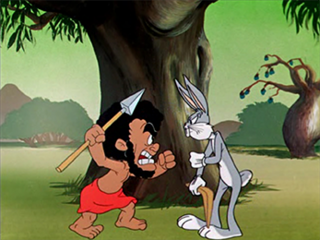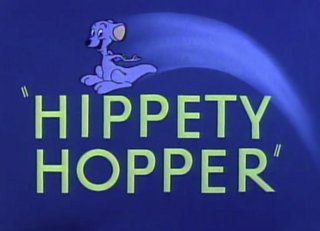Related Research Articles

Sylvester J. Pussycat Sr. is a fictional character, an anthropomorphic cat in the Looney Tunes and Merrie Melodies series of cartoons. Most of his appearances have him often chasing Tweety Bird, Speedy Gonzales, or Hippety Hopper. He appeared in 103 cartoons in the golden age of American animation, lagging only behind superstars Bugs Bunny, Porky Pig, and Daffy Duck. Three of his cartoons won Academy Awards, the most for any starring a Looney Tunes character: they are Tweetie Pie, Speedy Gonzales, and Birds Anonymous.

Hippety Hopper is a young kangaroo character in the Warner Bros. Looney Tunes series of cartoons. Robert McKimson introduced Hippety Hopper in Hop, Look and Listen (1948), which established the pattern for future Hippety Hopper cartoons. The character appeared in 14 theatrical cartoons between 1948 and 1964.

Scaredy Cat is a 1948 Warner Bros. Merrie Melodies cartoon directed by Chuck Jones. The short was released on December 18, 1948, and stars Porky Pig and Sylvester the Cat. The cartoon is notable in that it marks the first time the name "Sylvester" is used for the popular feline character. In previous shorts, the cat is unnamed, except for in the 1947 cartoon Tweetie Pie in which he is referred to as "Thomas".

Pop 'Im Pop! is a 1950 Warner Bros. Looney Tunes theatrical cartoon short directed by Robert McKimson and written by Warren Foster. The short was released on October 28, 1950, and stars Sylvester the Cat, Hippety Hopper and Sylvester Jr., in the latter's first appearance.

Bugs Bunny's Christmas Carol is an eight-minute animated film produced by Warner Bros. Television and DePatie–Freleng Enterprises, and aired on CBS on November 27, 1979 as the first segment of the Christmas special, Bugs Bunny's Looney Christmas Tales.

Cat-Tails for Two is a 1953 Warner Bros. Merrie Melodies cartoon, directed by Robert McKimson and written by Tedd Pierce. The short was released on August 29, 1953. It was the first appearance of Speedy Gonzales, in a prototype form. Because this cartoon's rendition of Speedy Gonzales looked rather coarse, they redesigned him for future cartoon releases.
Hop, Look and Listen is a 1948 Warner Bros. Looney Tunes cartoon directed by Robert McKimson. The short was released on April 17, 1948, and stars Sylvester and Hippety Hopper, in the latter's first appearance.

Sylvester J. Pussycat Jr., simply known as Sylvester Jr., is an animated cartoon character in the Warner Bros. Looney Tunes and Merrie Melodies series. He was created by Robert McKimson.

Bushy Hare is a 1950 Warner Bros. Looney Tunes cartoon directed by Robert McKimson. The short was released on November 18, 1950, and stars Bugs Bunny.

Gift Wrapped is a 1952 Warner Bros. Looney Tunes animated cartoon directed by Friz Freleng. The short was released on February 16, 1952, and stars Tweety and Sylvester.

Kit for Cat is a 1948 Looney Tunes cartoon directed by Friz Freleng. The short was released on November 6, 1948 and features Elmer Fudd and Sylvester.

Gonzales' Tamales is a 1957 Warner Bros. Looney Tunes animated film directed by Friz Freleng. The short was released on November 30, 1957, and stars Speedy Gonzales and Sylvester.

Claws for Alarm is a 1954 Warner Bros. Merrie Melodies cartoon directed by Chuck Jones. The short was released on May 22, 1954 and stars Porky Pig and Sylvester.
Freudy Cat is a 1964 Warner Bros. Looney Tunes animated short directed by Robert McKimson. The short was released on March 14, 1964, and stars Sylvester the Cat, Sylvester Jr. and Hippety Hopper.
Little Red Rodent Hood is a 1952 Warner Bros. Merrie Melodies animated short directed by Friz Freleng. The short was released on May 3, 1952, and stars Sylvester in a spoof of "Little Red Riding Hood".
A Mouse Divided is a 1953 Merrie Melodies animated short directed by Friz Freleng. The short was released on January 31, 1953, and stars Sylvester. The title is a pun on Lincoln's House Divided Speech.
Bell Hoppy is a 1954 Warner Bros. Merrie Melodies cartoon short directed by Robert McKimson. The short was released on April 17, 1954, and stars Sylvester the Cat and Hippety Hopper.
Cats and Bruises is a 1965 Warner Bros. Merrie Melodies cartoon directed by Friz Freleng and Hawley Pratt. The short was released on January 30, 1965, and stars Speedy Gonzales and Sylvester.
Road to Andalay is a 1964 Warner Bros. Merrie Melodies animated short directed by Friz Freleng and Hawley Pratt. The short was released on December 26, 1964, and is one of the last shorts to feature Speedy Gonzales and Sylvester.

Hippety Hopper is a Warner Bros. Merrie Melodies cartoon directed by Robert McKimson and written by Warren Foster. The short was released on November 19, 1949, and stars Sylvester and Hippety Hopper.
References
- ↑ Beck, Jerry (1991). I Tawt I Taw a Puddy Tat: Fifty Years of Sylvester and Tweety. New York: Henry Holt and Co. p. 126. ISBN 0-8050-1644-9.
- ↑ Beck, Jerry; Friedwald, Will (1989). Looney Tunes and Merrie Melodies: A Complete Illustrated Guide to the Warner Bros. Cartoons. Henry Holt and Co. p. 271. ISBN 0-8050-0894-2.
- ↑ Lenburg, Jeff (1999). The Encyclopedia of Animated Cartoons. Checkmark Books. pp. 60–61. ISBN 0-8160-3831-7 . Retrieved 6 June 2020.